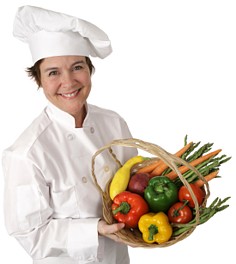Organizing Kitchen Cabinets
For each kitchen space you organize, the best approach is to consider the characteristics of its use. Kitchens are usually designed to offer the homemaker a variety of cabinet spaces. Their location, both in space and in relationship to kitchen appliances and work areas, as well as other attributes like shelf height and door type (solid or glass) can help you determine what to place where.
Keep in mind that your initial decision doesn’t have to be your final decision. As you use your kitchen more and/or acquire new or different kitchen equipment and as other factors enter the household, your decisions about the best location for various items may shift.
Types of Kitchen Cabinets
- Wall cabinets: These may be above counters, the stove, the refrigerator, the sink and/or on walls with nothing below them.
These kitchen cabinets are used to store items closest to where they are needed, so that generally dishes and cutlery are stored near the sink and/or dishwasher so they can easily be put away. Condiments are stored near the food preparation area and the stove, but not so near the heat that their quality is affected. Over stove storage is best used for cooking implements (like pots) rather than any foodstuffs.

- Base cabinets: These may be below counters and below the sink, and are more likely to contain drawers. A corner base cabinet may have a lazy Susan built in. Some sets may have a flour or potato bin.
The base cabinet beneath the sink is often used for cleaning supplies, including dish detergent, dishwasher detergent, floor cleaners, scrub brushes, paper towels, stainless steel pads, extra sponges, counter cleaner, etc.
- Pantry cabinets: They may include glass fronted cupboards.
These may be used for items that share functionality with attractive appearance, which—depending on the household—may include: home canning, cookbooks, attractive china, or glassware, or other items.
When considering how to use cabinets, consider what you wish to do with any space atop cabinets that is available. Some people use cabinet tops to store, some for display, and others incorporate both purposes.
Organizing Techniques
Some types of kitchen equipment are capable of being organized in different ways than others. Consider the advantages of:
- hanging (for example, tea cups)
- stacking (for example, plates, saucer cup sets, or platters)
- nesting (for example, bowls and pots)
- tiering (using plastic-covered wire racks)
- grouping (using, for example, a lazy Susan within a cabinet)
- grouping and stacking (using, for example, a cutlery tray)
- sliding (for example, inserting a sliding drawer into a cabinet; using a pull-out basket on gliders)
- using a rack (for example, a spice rack or a rack to store baking sheets, wire racks, pizza pans, and cutting boards on end)
Organizing Principles
Which principles you apply and how you apply them will depend on your answers to the above questions and, in some cases, making compromises between different approaches. The overriding principle should always be safety: this may mean making certain the cabinets cannot be opened by children (by locking them or using safety latches), or by storing any potentially hazardous items in alternative places.
- Place smaller items in front of larger items so it’s easy to see everything at a glance and people don’t need to “rummage” through the cabinet to find what they need.
- Place most frequently used items more accessibly than rarely used items—this may mean “in front” and/or “on a shelf that’s closer to eye level (as opposed to a very high or low shelf).
- Place heavy/large items in the base of the cabinet where they get the most support and will have the least chance of being dislodged when other items are being accessed.
- Group items by use, or
- Group items alphabetically (allspice, anise, basil, cardamom, cloves, fennel . . .), or
- Group items by size, placing all the tall items on one shelf, and ensuring that space is not wasted (for example, all tall bottles of oil and vinegar, storage for various types of flour, etc.)
- Group items in storage containers: lazy susans, plastic-covered wire racks, cutlery or tool trays, and sewing boxes can be used to contain and organize a large variety of items, including ones they might not have been designed for. The key to good storage is repurposing containers to work for you.
Written by Mary Elizabeth
